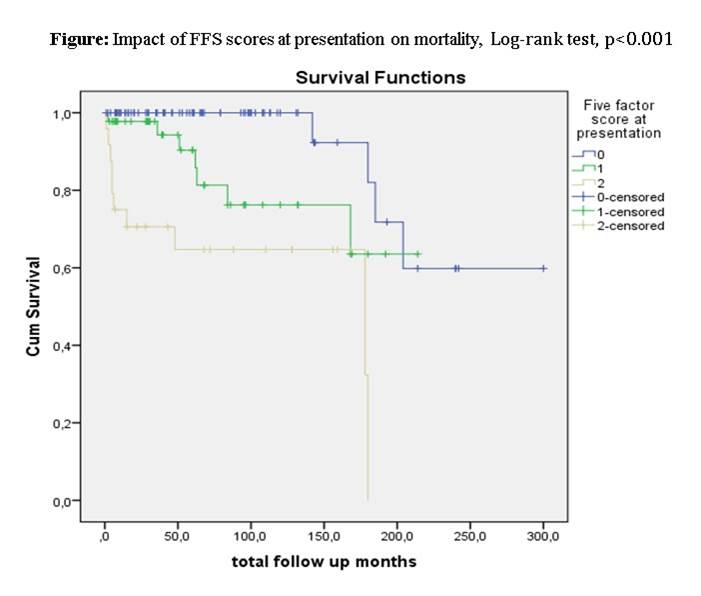Session Information
Date: Monday, October 22, 2018
Title: 4M091 ACR Abstract: Vasculitis–Non-ANCA-Assocd & Rel D/Os I: Population-Based Studies(1881–1886)
Session Type: ACR Concurrent Abstract Session
Session Time: 2:30PM-4:00PM
Background/Purpose: Polyarteritis nodosa (PAN) is a rare subgroup of the primary systemic vasculitides. Furthermore, various subgroups of PAN have been described, such as hepatitis B virus (HBV)-related, cutaneous PAN and monogenic forms. There is a paucity of information on the current phenotypes, ethnic and geographic differences of PAN.
This worldwide global study group collated the demographic, clinical features and outcomes of PAN cohorts from the United Kingdom (UK), Slovenia, Japan and Turkey (TR).
Methods: A retrospective survey of databases from five vasculitis centres between 1990-2016 for PAN patients fulfilling the EMEA Vasculitis Classification algorithm. Patients with typical angiographic and/or histopathologic findings consistent with PAN were included. We evaluated baseline characteristics, including demographics, organ involvement, treatment, activity and damage indices [BVAS, Five Factor Score (FFS), Disease Extent Index (DEI), Vasculitis Damage Index (VDI)] patient survival and time to relapse.
Results: 150 (M/F: 89/61) patients (UK: 47, TR: 67, Slovenia: 14, Japan: 22) were included in the study. Median age at disease onset was 37.0 (IQR 25.0-57.0) years. Four were HBV-related, 23.4% had paediatric onset. Sixteen of TR patients had a monogenic form of disease (FMF association in nine, deficiency of adenosine deaminase 2, DADA2, in seven).
Female predominance was found in cutaneous PAN (Table, p=0.013). No difference was found in the phenotype between paediatric and adult onset patients except for frequency of cutaneous lesions (100% vs. 63.8%, p=0.001, respectively).
Neurologic, renal and abdominal involvements were seen 42%, 49.3%, and 41.4% of patients, respectively.
55% of patients had radiologic, 70.3% had biopsy-proven PAN. Distribution of patients according to FFS score 0, 1 and 2 was; 52.4%, 31.3% and 16.3%, respectively. Mean BVAS score was 13.9 (8.2), VDI 1.1 (1.4) and DEI was 5.26 (2.8). Biologic agents have been used in 32 (21.3%) of them. During median 60 (20-109) months follow-up, nearly half of the patients relapsed around a year. Twenty-one patients died (nine of them during 5-year follow-up, six deaths were related to PAN). BVAS score was significantly higher in deceased group (24.5 (7.7) vs. 11.9 (7.9), p=0.003). FFS was significantly related to mortality (Figure, p<0.001).
Conclusion: This global study showed an extremely rare presentation of HBV-related PAN and a female predominance in cutaneous PAN in contrast to systemic PAN. FFS and BVAS scores are useful indices for morbidity and mortality in PAN. Biologic agents were required in 20% of patients.
To cite this abstract in AMA style:
Karadag O, Furuta S, Hočevar A, Gazel U, Gopaluni S, Armagan B, Tomsic M, Alibaz-Oner F, Ertenli I, Ozen S, Jayne D. Clinical Features and Outcome of Patients with Polyarteritis Nodosa – a Global Collaborative Study [abstract]. Arthritis Rheumatol. 2018; 70 (suppl 9). https://acrabstracts.org/abstract/clinical-features-and-outcome-of-patients-with-polyarteritis-nodosa-a-global-collaborative-study/. Accessed .« Back to 2018 ACR/ARHP Annual Meeting
ACR Meeting Abstracts - https://acrabstracts.org/abstract/clinical-features-and-outcome-of-patients-with-polyarteritis-nodosa-a-global-collaborative-study/


